Anna Rogstad – the first woman in the Storting
The first woman to take her seat in the Storting was Anna Georgine Rogstad (1854–1938). She was an active advocate of women’s rights, and was personally involved in pushing forward the changes that gave her the opportunity to run for election in 1909.

Anna Rogstad. The Storting’s photo archive. Photo: Szacinski
Anna Rogstad was 57 when she first took her seat in the Storting. She had extensive experience from an active professional life and her political engagement. Like many of the other women who played a leading role in the women’s movement, she was a teacher. She was both the driving force behind and the first director of what was to become a post-primary school for girls. Its popularity led to it being taken over by the municipality.
For many years, Rogstad was the schoolmistresses’ representative on the school board, and was also a member and later substitute member of the Kristiania[1] city council. She was one of the co-founders of the Norwegian Association for Women's Rights[2] in 1884 and the National Association for Women's Suffrage[3] in 1885.
Limited female suffrage
Between 1897 and 1903, Rogstad – in her position as a board member of the National Association for Women's Suffrage – was responsible for a number of proposals to give women the vote that were dealt with in the Storting. After limited female suffrage at local government elections was introduced in 1901, the National Association for Women's Suffrage tabled an alternative B to the proposed amendment to Article 50 of the Norwegian Constitution: census-restricted suffrage, as in local government elections. This alternative gained considerable support in the Storting, and the draft amendment was adopted on 14th June 1907 with a solid majority of 96 votes to 25.
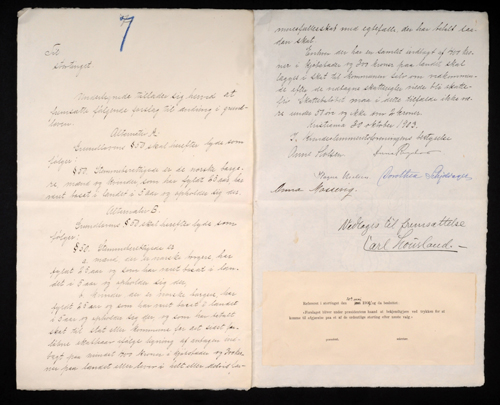
Proposal from the National Association for Women's Suffrage for amendments to Article 50 of the Norwegian Constitution, dated 30th October 1903. Storting Archives. The first signature belongs to Anne Holsen (1856-1913), co-founder and head of the organization from 1897. Holsen and Rogstad’s paths followed each other throughout their lives. Both were unmarried schoolmistresses, were engaged in local politics in Kristiania, and were among those who founded the Liberal Left Party.
The broad agreement in the Storting in 1907 to give women of a certain means and income the right to take part in the national political arena can probably be linked to the women’s petition backing the dissolution of the union with Sweden in 1905.
The women, who themselves were barred from taking part in the dissolution referendum, launched a large-scale campaign in support of the 7th June Resolution. It amassed almost 300,000 signatures. To put this into perspective, the total number of men who voted in the referendum was around 370,000. Such a demonstration of Norwegian women’s political commitment and capacity to galvanize support made a strong impression.
Anna Rogstad takes her seat in the Storting
The introduction of limited female suffrage in 1907 entailed that women were now eligible to stand for political office. In the 1909 parliamentary election, Anna Rogstad ran for the Liberal Left Party in an election pact with the Conservative Party. She was positioned second on the electoral list for the constituency of Gamle Aker in Kristiana, after Jens Bratlie, the Conservative Party’s leader.
In March 1911, Bratlie’s absence from the Storting led to Rogstad being summoned as his Substitute MP. The first time she took her seat in the Storting Chamber, the President made the following speech to a full chamber of standing MPs and a packed public gallery:
“This day, the 17th of March 1911, will be a day to remember in our country’s history, because today is the first time a woman takes her place in the Storting as one of its Members of Parliament – an event which will undoubtedly draw widespread attention. As to whether the time was ripe for the introduction of the reform that this event is due, opinions have been divided within our nation; but I feel convinced that in times to come, one will increasingly understand that this reform has been of the nature to bring honour and glory to our country, and that it has had an impact, and will continue to have an impact, in political terms, beneficial to the development of our country.”[4]
Peace matters, school policy and tax laws
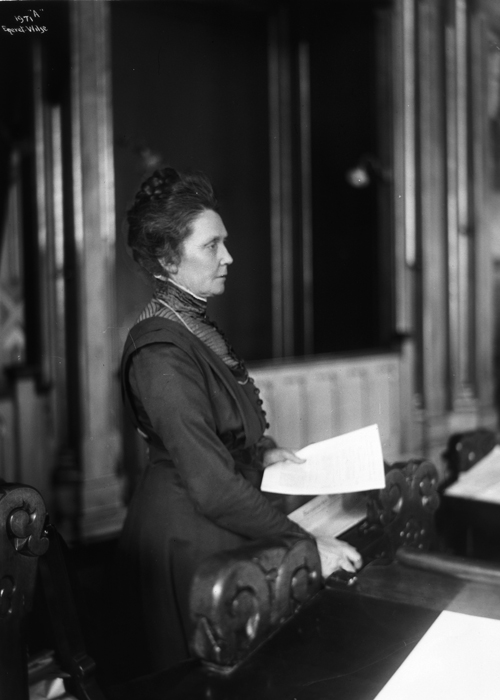
Anna Rogstad in the Storting Chamber. Norsk Folkemuseum. Photo: Anders Beer Wilse
Anna Rogstad was involved in three quite distinct issues during the time she served as a Substitute MP in March and June 1911. The first matter she addressed in the Storting was the defence budget. Rogstad was a keen proponent of peace, and she spoke warmly in favour of arbitration during her first speech from the Storting’s rostrum. But, since efforts for peace had not progressed further than they had, she said, Norway could not give up its defence, and so she leant her support to the Government’s budget proposal.
At the same time, Rogstad took the opportunity to disagree with those who believed that Norway was too small to play a leading role in peace and arbitration efforts. “I hope that in this matter as well, our nation will be among the pioneers,” she concluded.[5]
A few days later, Rogstad took the chance to speak on a matter that was within her own remit of education. She made a long and informed speech about the organization of schools for the deaf. But the issue in which Anna Rogstad truly made a name for herself was the Odelsting’s comprehensive consideration of the taxation laws, a matter which spanned several days in June 1911.
The right of wives to a tax assessment – the taxation laws
With women’s rights in mind, Rogstad raised an issue that she believed was absent from section 16 of the Taxation Bill: the assessment of spouses. The committee’s recommendation stated that “the husband is assessed for both his own and his wife’s total assets and income, irrespective of whether the wife has separate property from which she derives income.” In Rogstad’s view, this wording indicated that a wife could only derive income from assets, and not from her own work.[6]
How would such legal wording be applied in cases where the wife was the primary breadwinner? She argued that it would be both unreasonable and have an adverse effect on the calculation of tax if a husband who was unfit to work were assessed for his wife’s income.
To start with, Rogstad’s question prompted little response, but by repeating the question, and insisting that there must be a formal error in the bill, she compelled some of her fellow MPs to speak.
Edvard Hagerup Bull from the Conservatives took the floor “in response to Miss Rogstad’s continued request” to remark that the intention was that one would be assessed whatever the case. He argued that there were exceptionally few instances where the wife was the breadwinner, and added that it would be unfortunate to start poking around in the private affairs of a family to find out whether a husband earned little or nothing. Perhaps the wording of the bill was less than gallant towards the wife, but he was unable to see that there were any loopholes in it.[7]
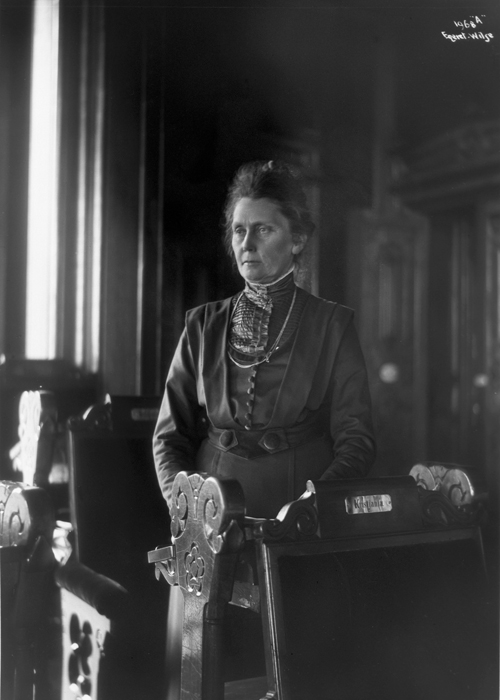
Anna Rogstad in the Storting Chamber. Norsk Folkemuseum. Photo: Anders Beer Wilse
Rogstad with a breakthrough
Rogstad was not to be put off, however. She refused to accept that the issue was anything to do with gallantry; rather, this was a purely practical question. The matter would be cleared up if the wording of the bill could specify that the wife would be assessed if her husband had no income.
Eventually, several of Rogstad’s fellow MPs came forward and acknowledged that the wording was inadequate. One of Hagerup Bull’s party colleagues, Christian Fredrik Michelet, believed that Miss Rogstad’s words were based on solid reasoning. He urged the committee to reconsider section 16 of the bill, to which the committee’s chairman, Wollert Konow (Liberal Party, Hedemarken), agreed.
The following day, the President of the Storting complied with the committee chairman’s request that section 16 of the bill should not currently be considered in order that more time could be given to Rogstad’s proposal. In the words of Konow, it would be a most unfortunate state of affairs if a husband “could walk around with a large tax bill in his pocket, while in fact he was a complete scoundrel of a man who perhaps squandered his wife’s income.”[8]
When the section in question was considered once again two days later, the committee added an extra sentence to the bill: “If the husband has no income, his wife shall be assessed for her income as the taxpayer.”[9]
Anna Rogstad’s perseverance convinced the majority to turn. Though Rogstad herself said she was happy with the proposal’s new wording, several other MPs had their reservations. Yet another Conservative Party MP, Jørgen Herman Meinich, tabled a motion that went even further. He proposed to give wives the right to be assessed separately for their own assets and income.
Meinich’s view was that Rogstad would achieve more by supporting his proposal. The Official Report of the Storting gives no indication of how Rogstad voted in the matter, but Meinich’s proposal was ultimately adopted by 44 to 38 votes.
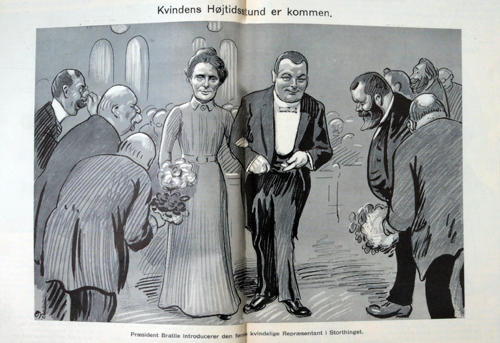
Anna Rogstad being escorted into the Storting as Jens Bratlie’s bride. Caricature, probably by Eivind Nielsen, in the satirical magazine Vikingen, 4th February 1911.
Rogstad’s reception in the Storting
Anna Rogstad was a fearless and capable speaker, who by and large won the respect of her fellow MPs. Yet the very fact that she was a woman meant that she also encountered prejudice. After her maiden speech in the Chamber, one of her own party colleagues, Bernhard Hanssen, said he was pleased to hear that she backed the arbitration matter, but added that women could not be said to bring any truly effective momentum to the issue at present.
He went on to say that he hoped the future would show “that women will become an exceptionally important part of the great efforts for peace and arbitration in the world, and we therefore also welcome women to the national assembly so that they can support these noblest endeavours of humankind.”[10]
Hagerup Bull’s attempts to trivialize Rogstad’s objections to section 16 of the Taxation Bill by labelling it a question of etiquette, and showing obvious irritation over having spent so much time on the matter was also an expression of a mildly arrogant attitude towards a female colleague. But Rogstad’s impact in the Taxation Bill issue were proof that her views were being listened to.
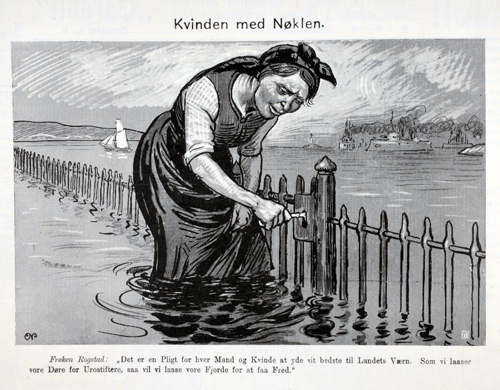
“Just as we lock our doors to troublemakers and rabble-rousers, we will also close our fjords to keep the spectacle of war outside,” said Rogstad in a debate on the naval plan on 5th July 1912 (Official Report to the Storting 2587-88). Drawing, probably by Eivind Nielsen, in Vikingen, 20th July 1912.
Rogstad substitutes for Bratlie in 1912
When Jens Bratlie became Prime Minister in February 1912, Anna Rogstad took her seat as his Substitute for the rest of the parliamentary term. That year, she displayed great versatility by taking the floor in 29 different debates in the Storting and the Odelsting.
In addition to school and education policy, Rogstad took an active interest in health and care questions, and matters relating to defence, construction and working life, to name but a view. She was first a member of the Standing Committee on Church Affairs, but from 1912 onwards became a member of the Standing Committee on Business and Industry, where she was committee spokeswoman on a number of issues.
Universal suffrage in 1913
There is little doubt that the engagement and skill Anna Rogstad displayed while she was a Member of Parliament helped to change opinions in the battle for the women’s vote.
During the debate on the Taxation Bill, she also said that it was her “firm hope that the Storting within this session would ensure that universal suffrage for women was adopted.”[11]
Women gained universal suffrage at local government elections in 1910. There was therefore considerable tension surrounding the Storting’s consideration of the draft constitutional amendment on universal suffrage for women in 1911.
The recommendation from the Standing Committee on Constitutional Affairs asserted that “[w]omen’s participation in the local government elections shows that they have great interest in the conduct of public affairs, and this interest became even more apparent at last year’s parliamentary elections.”[12]

Anna Rogstad by Eyolf Soot, 1914. Storting. Photo: Teigens Fotoatelier. The painting was presented as a gift to the Storting by a group of Norwegian women, including Ragna Nielsen, Fernanda Nissen and Harriet Backer, four years after Rogstad’s first appearance as a Substitute MP in the Storting. A letter to the Storting’s Presidium, referred to in the Storting’s Official Report of 17th March 1915, stated “In commemoration of the first time a woman was a Member of the Storting, we take the liberty of sending the esteemed Storting a portrait of Miss Anna Rogstad from Norwegian women. Kristiania, 17th March 1915.”
There was great disappointment when the committee’s recommendation to introduce voting rights for women along the same lines as for men failed to gain the requisite two-thirds majority when it was put to the vote on 10th August 1911. Yet the final result of 73 for and 47 against (among them, Bratlie and Hagerup Bull) showed that those in favour were close to the majority needed, and a new draft constitutional amendment was quickly tabled.
On 11th June 1913, the Storting finally voted to extend Article 50 of the Constitution to include “Norwegian citizens, men and women” over the age of 25. The constitutional amendment to introduce universal suffrage in Norway was unanimously adopted.
As with the introduction of universal male suffrage in 1898, a provision was included in the Constitution which deprived those on poor relief from being able to vote. Arguably, it was not until this provision was repealed in 1919 that the vote in Norway became truly universal.
Sources and literature
This article is a translation of a Norwegian article which can be found on the Storting’s Norwegian website. The sources and literature for the original article can be found here: Anna Rogstad – første kvinne på Stortinget i 1911.
[1] Christiania/Kristiania was the name for Oslo between the years 1624 and 1925.
[2] Norsk Kvindesagsforening
[3] Kvindestemmeretsforeningen
[4] Official Report of the Storting 700, 1911
[5] Official Report of the Storting 764, 22nd March 1911
[6] Official Report of the Odelsting 825, 26th June 1911
[7] Official Report of the Odelsting 827, 26th June 1911
[8] Official Report of the Odelsting 830, 27th June 1911
[9] Official Report of the Odelsting 886, 29th June 1911
[10] Official Report to the Storting 764, 22nd March 1911
[11] Official Report to the Storting 891, 29th June 1911
[12] Recommendation to the Storting XXXXV, 1910
Last updated: 25.07.2025 10:17